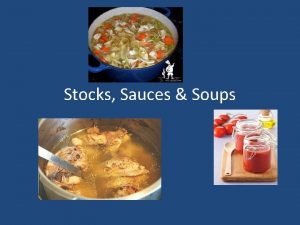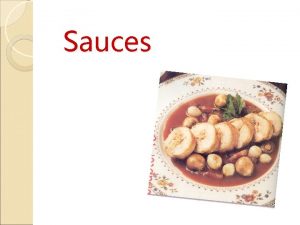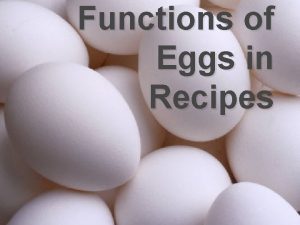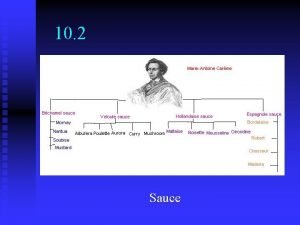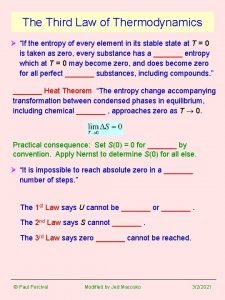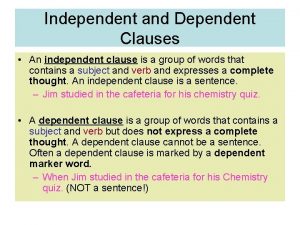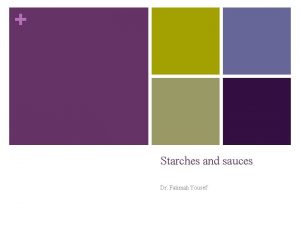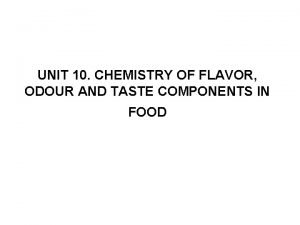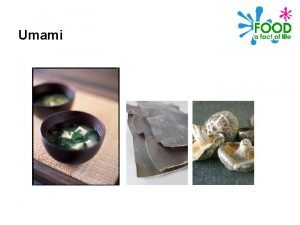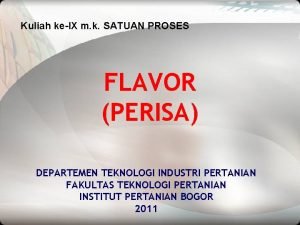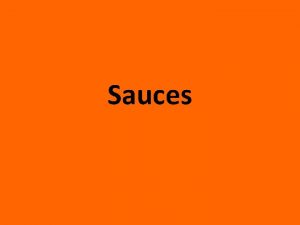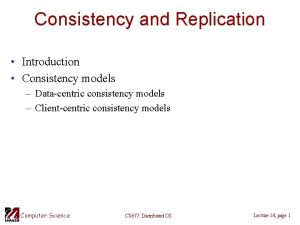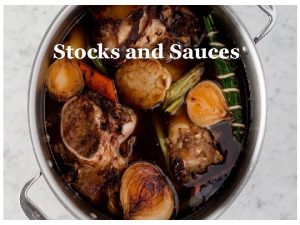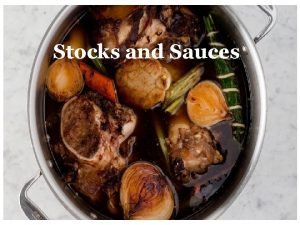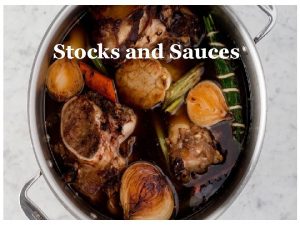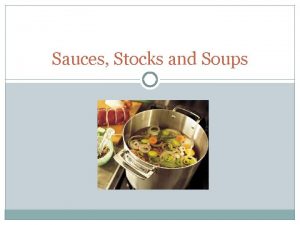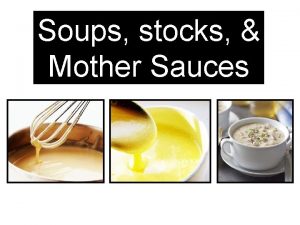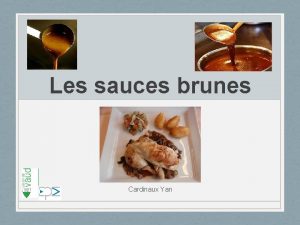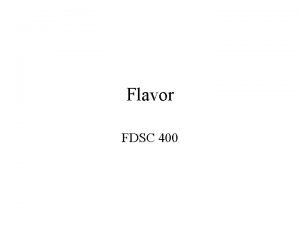Thickening Sauces Sauces depend on flavor and consistency



















































- Slides: 51

Thickening Sauces

Sauces depend on flavor and consistency in order to be successful element of a dish. Most sauces should evenly coat the food they accompany in a smooth glossy layer.

Over thickened sauces are heavy and distract from the balance of flavors. Thin sauces slide around the bottom of a plate and don’t deliver the “punch” of their objective.


When it comes to flavor: Thin sauces have a more intense and direct flavor impact but will not have as lasting an effect on the palate.

Adding a starch thickener helps the sauce cling to the tongue but is can block flavors so they may require more seasoning or flavoring.

The goal of thickening a sauce is to add: 1. Viscosity 2. Texture 3. Mouth-feel This helps the flavor of food to linger on the tongue and taste buds. This make food more enjoyable. There are numerous ways to thicken and enrich sauces, soups, and other dishes.

They are as simple and basic as a whitewash made with flour and water, as light as a slurry made of arrowroot, or as complex as a dark brown roux. Contemporary trends have brought the use of refined starches and even foams into the mainstream of culinary arts.

Thickening agents fall into one of the following areas. Suspension: Pureed foods especially vegetables, fruits, and herbs. Dispersion: Starches, pectin, and gelatin work by swelling and absorbing liquids to create viscosity in sauces, jams, and aspic.

Emulsion – Suspension of fats in liquid. Examples of this are hollandaise and mayonnaise

Two or more normally unmixable liquids including fats and oils, combined with emulsifiers of cream, egg yolk (which contains lecithin), ground herbs, and spices.

Foam – Incorporating air into cream or other products, sometimes with the aid of leavening agents to create a textured flavored puff structure. Foams are technically solids with air immersed in the structure, but are used as a lite substitute for traditional sauces


Foams tend to be temporary unless stabilizers are incorporated into them

Reduction Allowing the liquid base of a sauce to gently evaporate by simmering. This creates an intense, flavorful sauce that need little thickening

This is one of the simplest form of a sauce. Even in a basic form, reductions add an intense element to a dish. Most reductions are based on utilizing the Fonds in a pan from searing meat. By adding wine, acid, and stock, and allowing it to reduce and concentrate.


Because meat contains gelatin, a natural thickening agent, it has a savory richness that lingers on the tongue. A reduction of a stock, called a glace, is prepared by cooking down and concentrating its flavor which also increases the viscosity. Sauces prepared in this manner will have an intense flavor unobstructed by thickening agents.

Veal and Brandy Glace

They are also prohibitively expensive and are therefore not practical in a casual dining operation. A glace though can be useful as a natural enhancement to enrich weak sauces.

Using Flour to Thicken Flour combined with a fat (typically butter) is called Roux is one of the best tools for building flavor and texture in a sauce. Traditional roux is made with wheat flour. The most common thickening agent used in kitchens for hundreds of years. A P Flour is added in various ways but is best when combined with fat to prevent lumping in the sauce.

It is important to note when making roux: Prolonged exposure to heat will cause flour grains to close up and therefore not swell as much when dispersed in liquid, so the more a roux is cooked the less thickening power it possesses.

Flour serves two purposes: 1) The flour will retain more liquid and therefore have a better mouth feel and helps deliver the flavor of the dish 2) When liquid is added, the flour granules will swell creating a viscous sauce.

Whitewash: The most basic type of thickening agent, whitewash is flour blended with water to make a paste. The flavor can be quite pasty and raw in taste. This is rarely done in professional kitchens today. Lighter roux, like white and blond, is used in white sauces, Béchamel and Velouté

Darker roux is used in brown sauces and regional cuisines including Creole and Cajun cooking.

Beurre Manié : Referred to as kneaded butter, it is equal parts softened butter and flour that are worked together into a smooth paste. It is used at the last minute to adjust the consistency of sauces, soups, and stews. Usually used at the end of the cooking process. It adds a light thickness to sauces.

Buerre Manie Citrus Buerre Blanc thickened with Buerre Manie

TYPES OF ROUX White or Pale Roux Uses: Cream soup, Béchamel sauce Blond Roux Uses: Velouté sauce, soups, white stews

Brown Roux Uses: Espagnole sauce, brown stews and braises

Brown roux will lose about 1/2 to 2/3 of its thickening power compared to a white or blond roux

Black Roux Uses: Gumbos and Cajun stews

Use oil because it has a higher smoke point than butter and will prevent scorching. Black Roux gives soups and stews a definite smoky flavor. It is usually incorporated into sauces that are paired with seafood and smoked meats

How Much to Thicken: Although there are basic ratios for the amount of liquid to roux is needed to thicken a liquid, be mindful of variables that produce different results.

Some of these include: The amount of Starch in a particular flour The Gluten content The moisture content More starch and less protein are desirable for a roux so avoid high protein bread flour. The age of the flour affects the flours ability to absorb and swell.

Heat and the amount of cooking time a roux is cooked affects its thickening power. Brown roux will have about half the thickening power of a blond roux because the grains of flour have seized up and become closed during prolonged cooking. Other factors that affect the power of thickening agents include salts, sugars, and acids

Refined Vegetable Starches Slurry Equal parts of liquid and a refined starch mixed together and added to a simmering liquid to thicken

Refined vegetable starches are simple thickeners that require little time to prepare and are neutral in taste. They are combined with water or other liquids to create a slurry before adding to hot liquids. This prevents the starches from clumping. Prolonged cooking can weaken the power of these starches so they are usually added at the end of the cooking process.

Arrowroot – The root of a perennial plant, arrowroot has a neutral taste that is preferred by chefs over flour or cornstarch, and thickens at a lower temperature than either of the others. It is not affected by acidic ingredients or by freezing. But it is not recommended in combination with dairy products because it produces a slimy texture. Overheating tends to break down arrowroot's thickening property.

Cornstarch: Refined from the endosperm of corn, cornstarch produces a clear mixture used for sauces, glazes, pie fillings, and puddings. It tends to weep and clump up when held hot

Potato Starch: A starch that acts similar to arrowroot and results in a translucent appearance. Rice Flour: A gluten-free alternative, rice flour is a more expensive thickener and possesses slightly weaker thickening power than arrowroot. It is used similar to cornstarch

Liaison: The word liaison broadly describes the process of thickening a sauce using starch (such as flour or cornstarch), egg yolks, fat, and even foie gras or puréed vegetables.


Most commonly, however, liaison refers to a mixture of egg yolks and heavy cream that is used to thicken a sauce. Sometimes called liaison finale, or final liaison, because it is (both by tradition and necessity) the last thing that is added to a sauce. If heat is applied over a period of time, the egg in the liaison will break, or separate out of the sauce leaving bits of eggs floating around. This will ruin the uniform smoothness of the sauce.

Monte au Buerre A very simple liaison is achieved using the technique known as monte au beurre Monte au Buerre is the finishing technique of adding a mound of butter to a saucer just before serving.


This works as a way of creating a quick emulsion, but for only a small amount of sauce. It thickens and enriches the sauce to the point where it might overwhelm the item that it accompanies.

Ingredients used for Liason: Eggs Heavy Cream Butter Blood Fish Roe (caviar) Most of the time, when a recipe calls for a liaison, it means adding a mixture of egg and cream at the end of the suacemaking.

REDUCTION VS. THICKENING WITH A LIAISON Reductions have a cleaner taste and smoother consistency. Reduction significantly increases cost with the dramatically lower yield. Using a liaison preserves the yield and lowers the cost. Liaisons may adversely affect flavor and texture. Liaisons additional calories and/or fat.

Final Seasoning for a Sauce It is important to remember that the base of the sauce and the thickened sauce will not taste the same. Thickeners alter and dull the flavor


To balance the flavor and seasoning of your sauces consider all the basic taste sensations Salt is the most primal taste and reduces bitterness Bitterness is derived from herbs and spices including tarragon, sage and peppercorn Sweet is added with the addition of sugar, butter, and cream Butter also adds a savory sensation Acidity lifts and lightens the flavor of the sauce on the tongue; a little wine vinegar, wine, or lemon can do this Umami is the savory taste found in meats, poultry, fish, cheese, tomatoes, and mushrooms
 Replicated data consistency explained through baseball
Replicated data consistency explained through baseball Image
Image Morphological processing in digital image processing
Morphological processing in digital image processing Why plants and animals depend on each other
Why plants and animals depend on each other Drive right chapter 8
Drive right chapter 8 Is the liquid that forms the foundation of sauces and soups
Is the liquid that forms the foundation of sauces and soups Primary thickening meristem
Primary thickening meristem Sauces classification
Sauces classification Brown sauce derivatives
Brown sauce derivatives Dynamic viscosity symbol
Dynamic viscosity symbol Leavening agent egg example
Leavening agent egg example Leading sauce
Leading sauce Kien a
Kien a Peribronchial thickening
Peribronchial thickening Ligamentum flavum thickening
Ligamentum flavum thickening Thickening of uterine lining
Thickening of uterine lining Erosion image processing
Erosion image processing Quad tendon ultrasound
Quad tendon ultrasound What does the speed of sound depend on
What does the speed of sound depend on What does the speed of sound depend on
What does the speed of sound depend on Why does a star's life expectancy depend on mass
Why does a star's life expectancy depend on mass Does morality depend on religion rachels summary
Does morality depend on religion rachels summary Cppdepend
Cppdepend Vant hoff factor of glucose
Vant hoff factor of glucose Physical properties of elements
Physical properties of elements Chapter 14 water supply systems
Chapter 14 water supply systems Colligative properties depend on
Colligative properties depend on Third law of thermodynamics is depend on
Third law of thermodynamics is depend on 4 colligative properties
4 colligative properties Couleurs des objets
Couleurs des objets Define codependent
Define codependent What do the phases of the moon depend on
What do the phases of the moon depend on Indepent clause
Indepent clause I/o management and disk scheduling
I/o management and disk scheduling Factors affecting momentum
Factors affecting momentum Applications of colligative properties
Applications of colligative properties Source of starch
Source of starch Taste vs flavor
Taste vs flavor Umami meaning
Umami meaning Fema gras list
Fema gras list Contoh flavor sintetis
Contoh flavor sintetis Language
Language Flavor vs taste
Flavor vs taste Operating system flavor
Operating system flavor Cocktail flavor wheel
Cocktail flavor wheel Chapter 10 lipids nature's flavor enhancers answers
Chapter 10 lipids nature's flavor enhancers answers How does salt lose its flavor
How does salt lose its flavor Perbedaan penguat rasa dan penyedap rasa
Perbedaan penguat rasa dan penyedap rasa Contoh flavor sintetis
Contoh flavor sintetis Zat anti gizi
Zat anti gizi Komponen non gizi jenis zat warna dan flavor terdiri dari
Komponen non gizi jenis zat warna dan flavor terdiri dari Flavor pyramid
Flavor pyramid





